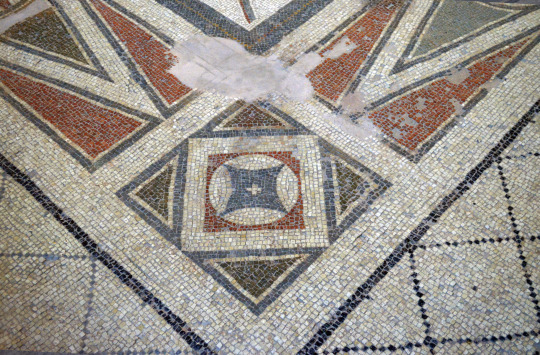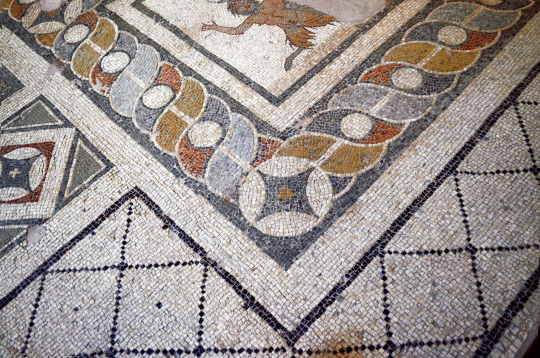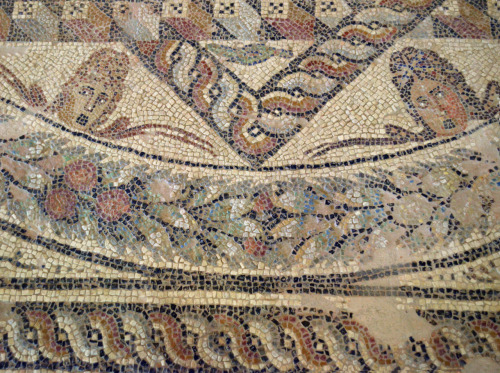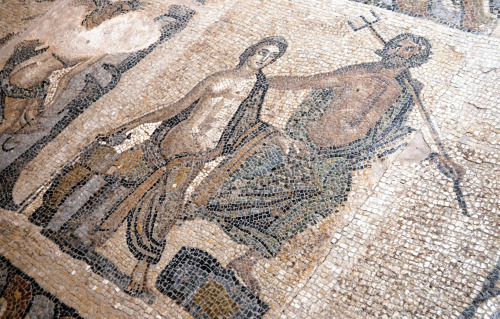#archaeological museum of chania
Crete, Archaeological Museum of Chania:
Triclinium from the House of Dionysos
In the large panel Dionysos is depicted on a panther followed by a satyr. In the border part, the artist’s signature is preserved indicating his provenance; Daphne, a suburb of Antioch, where there was a famous mosaic school at the time. The legend of Dionysos and Ariadne of Naxos is depicted in the best preserved smaller panel. The comic masks allude to the relationship of Dionysos with theatre.
Found in the town of Chania (ancient Kydonia), near the Market Square in 1977.
The best preserved scene of the same triclinium with Dionysus and Ariadne at Naxos, as well as some decorative details on these two posts 1,2.
Part of the preserved signature: …(from) Daphne made.

Some of the decorative geometric designs.


The scene with the panther.

A scene with actors from the same triclinium.

Post link
Crete, Archaeological Museum of Chania
Panel with the legend of Dionysos and Ariadne of Naxos, from the Triclinium of the House of Dionysos.
In a large panel Dionysos is depicted on a panther followed by a satyr. In the border part, the artist’s signature is preserved indicating his provenance; Daphne, a suburb of Antioch, where there was a famous mosaic school at the time. The legend of Dionysos and Ariadne of Naxos is depicted in the best preserved smaller panel. The comic masks allude to the relationship of Dionysos with theatre.
Dated 3rd century A.D
Found in the town of Chania (ancient Kydonia), near the Market Square in 1977.
Post link
Crete, Archaelogical Museum of Chania:
Decorative, square from the triclinium of the House of Dionysos.
In the large panel Dionysos is depicted on a panther followed by a satyr. In the border part, the artist’s signature is preserved indicating his provenance; Daphne, a suburb of Antioch, where there was a famous mosaic school at the time. The legend of Dionysos and Ariadne of Naxos is depicted in the best preserved smaller panel. The comic masks allude to the relationship of Dionysos with theatre. Found in the town of Chania (ancient Kydonia), near the Market Square in 1977.
Dated 3rd century A.D.
Detail from another one of the squares.

Post link
Crete, Archaelogical Museum of Chania:
Decorative, border details from the triclinium of the House of Dionysos.
In the large panel Dionysos is depicted on a panther followed by a satyr. In the border part, the artist’s signature is preserved indicating his provenance; Daphne, a suburb of Antioch, where there was a famous mosaic school at the time. The legend of Dionysos and Ariadne of Naxos is depicted in the best preserved smaller panel. The comic masks allude to the relationship of Dionysos with theatre.
Dated 3rd century A.D
Found in the town of Chania (ancient Kydonia), near the Market Square in 1977.
Post link
Crete, Archaeological Museum of Chania:
Mosaic of Poseidon and Amymone.
The central part of the “triclinium” of a private house from greco-roman Kydonia. The depicted myth is developed in two scenes: On the left Amymone is attacked by a satyr at Lerni spring. On the right, Poseidon helps Amymone, after rescuing her. In a separate frame a cock fight is depicted as an allusion to the erotic quarrel.
Dated to the middle 3rd century A.D
Found at the town of Chania (1866 square) in 1937.
Detail from a decorative medallion depicting a Medusa head.

A full view of all the scenes depicted on the mosaic.

Post link










